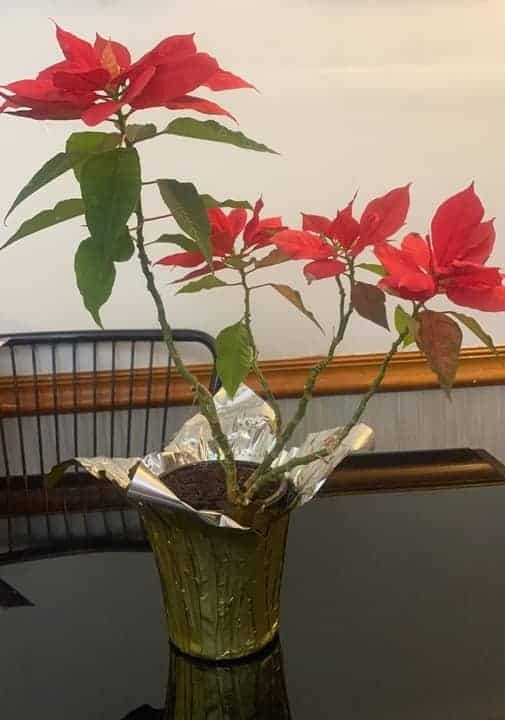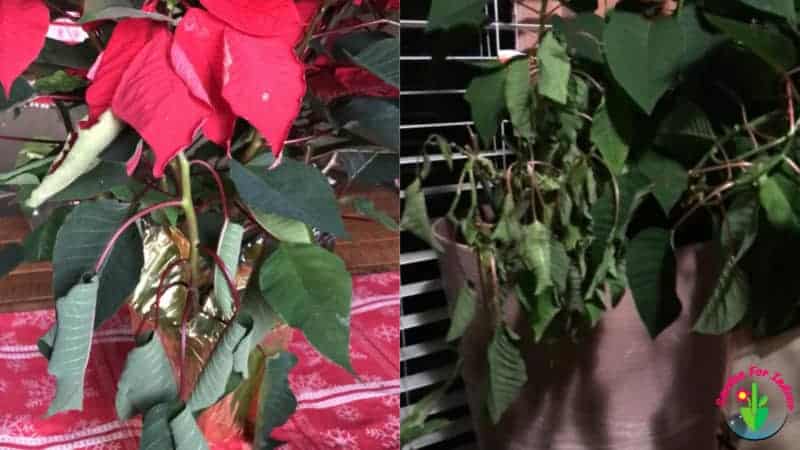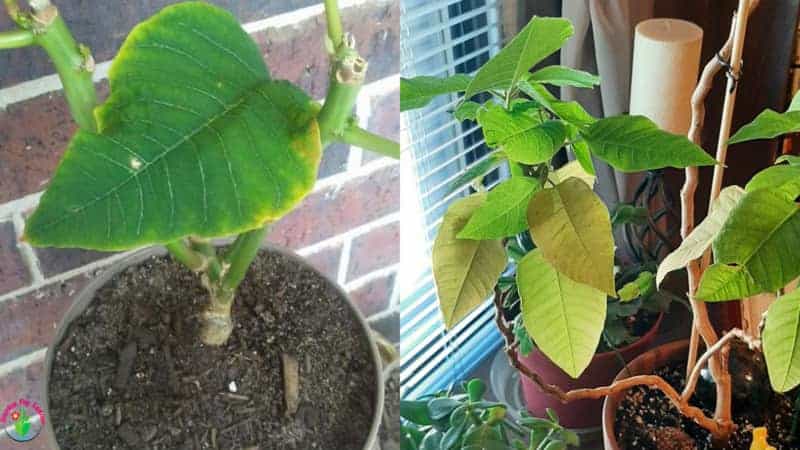Providing your poinsettia with the appropriate amount of light daily will help it thrive and remain beautiful.
It will become sunburned and develop leggy, unsightly growth if it receives too much or too little light. So, how much light does a poinsettia require to thrive?
Poinsettias require at least six hours of bright, indirect sunlight per day to thrive. While exposure to the east is preferred, indirect light from a south or west-facing window will suffice. Insufficient light results in leggy growth and defoliation, whereas scorched foliage indicates an excess of light.
Keep reading to learn more about poinsettia light requirements. I’ll also explain some of the critical symptoms of your poinsettia: either getting too much or too little light.

Contents
- Do Poinsettias Need a Lot of Light?
- What Kind Of Light Does A Poinsettia Need?
- Do Poinsettias Like Sun or Shade?
- Where Should You Place a Poinsettia?
- Signs That Your Poinsettia Isn’t Getting Enough Light
- How to Provide More Light
- Signs That Your Poinsettia Is Getting Too Much Light
- What to Do If the Poinsettia Is Getting Too Much Light?
Do Poinsettias Need a Lot of Light?
Poinsettias are relatively hardy plants and tolerant of various light levels. However, they do enjoy plenty of light.
I recommend giving your plant a minimum of six hours (preferably 8-10 hours) of indirect and bright sunlight.
An abundance of bright light helps your poinsettias attain optimal growth. It is needed for photosynthesis and the production of healthy green foliage.
Be that as it may, you might want to avoid exposing your plant to direct sunlight, especially during summer.
It can tolerate only one to two hours of direct sunlight. Exposure to too much direct and hot sun will scorch the leaves. The foliage will also become bleached and appear browned at the edges.
If that isn’t horrible enough, too much heat will cause the brightly-colored bracts to lose color.
What Kind Of Light Does A Poinsettia Need?
While poinsettias can tolerate many different light conditions, they are happiest in bright, indirect sunlight.
They will survive insufficient light, although they won’t attain the best growth in these conditions. Its green leaves will turn yellow or pale due to chlorosis.
Your poinsettia can sit in direct sunlight, but for a limited time. The leaves will burn, crisp up, and dry if they get too much direct sunlight.
It would be best to put your poinsettia in a brightly lit spot in your home, but keep the intensity of the light in mind.
Exposure to Sun
I must reiterate that poinsettias are very fussy about exposure to direct sun. They can tolerate the mild morning sunlight. But, when the scorching afternoon sun arrives, your plant will require dappled light.
If you sit your poinsettia in front of a west-facing or east-facing window, it won’t get 6+ hours of bright light it needs in a day. To make matters worse, light hours reduce drastically when winter approaches.
If you don’t mind the work, you can move it throughout the day. Place it in an east-facing window during the morning hours.
Then, in the afternoon, you can move it to a west-facing window, where it will get enough dose for the day.
However, you must use a light curtain or sheer to diffuse or filter the harsh sunlight from a west-facing window.
When all’s said and done, placing your poinsettia a little removed from a south-facing window will be perfect.
This will ensure that your plant will get plenty of indirect and bright sunlight simultaneously. Don’t forget to use drapery.
The good news is that poinsettias don’t mind artificial light. Pick a few LED grow lights and increase exposure to around 12 or more hours daily.
The Direction of the Sun
Choosing the placement of your poinsettia will depend on where sunlight lands in the room.
It’ll love the soft morning sunlight lighting from an east-facing window or door. Unfortunately, the window won’t get much sun action in the afternoon.
During the spring and summer, light from a north-facing window is dimmed. So, it won’t work for your poinsettia direction-wise.
Western window exposure is the harshest during the afternoon when the brightest sun is burning.
That means the leaves will bear the brunt of the direct sunlight. Thankfully, a poinsettia enjoys a little dappled light.
You should place it in a sheltered spot near a west-facing window. It will enjoy bright light without getting hit by direct sun. But will it get more than 6 hours of good light from this direction?
Probably not. That’s where southern exposure comes into play.
A south-facing window will deliver the most reliable bright light. Just park your plant a few yards from the south-facing window to ensure it gets indirect sunlight.
From this direction, your poinsettia will enjoy evenly bright sunlight throughout the day.

The Intensity of Light
The intensity of sunlight your poinsettia receives is the highest during the growing period. That’s between early spring to late summer.
Poinsettias need plenty of bright, intense light to photosynthesize, generate energy, and build their food reserve.
Once the fall season arrives in November, the light intensity reduces drastically. It remains low throughout the winter months. Coincidentally, this is when your poinsettia will enter into dormancy and experience little to no growth.
Poinsettias need around 14 hours daily of total darkness in November and December. It will need roughly 8 hours to produce its brightly colored bracts. They won’t bloom if they don’t get enough dark hours.
Do Poinsettias Like Sun or Shade?
Short answer: the partial sun.
While poinsettias can tolerate some shadow, they’ll flourish the most in sunny conditions. The real issue is whether they prefer direct vs. indirect sunlight.
If you’re a newbie, you might wonder what indirect or direct light is. The answer is simple: poinsettia loves the bright, indirect sun. What is the difference?
Your plant pro is here to make everything clear. If your poinsettia is getting unfiltered sun rays on its leaves, that’s direct sunlight. You wouldn’t want to expose your plant to too much of that.
The best way to gauge is to use a hand-shadow test. If you can see a well-defined, clear hand shadow, then that spot likely gets direct sunlight.
If your poinsettia is sat in an area where unfiltered sunlight doesn’t hit the leaves, it’s getting indirect light.
The hand shadow here is pretty blurry and indistinct. But you can still tell it is a hand’s shadow.
Light diffused from the floors, reflected by mirrors, and bouncing from the walls is indirect light.
Your poinsettia will be happy in a spot that gets this kind of light. You can say it’s dappled – part sun, part shade.
Where Should You Place a Poinsettia?
It would be best to place your poinsettia in the brightest spot in your house. However, the light hitting the leaves should be indirect, diffused, filtered, or both.
The table below gives some pointers you should consider when picking the right spot. You can measure the light intensity with a light meter. (Amazon link)
| House Placement | Light Intensity (Lux) | Light Type |
| – Tree-shaded windows- Basements- Windowless rooms- Hallways, bathroom, staircase | Less than 100 | Dimmest (fully shaded) |
| – 5-6 ft from an east-facing window- North-facing window (with no direct sunlight) | 100-500 | Low light (partially shaded) |
| – 5 ft from the window- Brightly lit areas but no direct sunlight | 500-1000 | Medium-bright light |
| – Behind sheer drapery/curtain- 3-4 ft from south, west, or east-facing window- Sunny only for a few hours | 10,000-25,000 | Indirect sunlight Note: This is the perfect spot to place your poinsettia. |
| – Less than two feet from the east or south-facing window- Sunrooms- Balcony, patio, etc.- Window sill | 32,000- 100,000 | Direct sunlight (full sun) |
As you can see, placing your poinsettia three to four feet from an east-facing, west-facing, or south-facing window would be perfect. (Source)
Signs That Your Poinsettia Isn’t Getting Enough Light
[1] Stunted Growth and Small Leaves
You don’t want your poinsettia to be in low light conditions. Although lack of light won’t kill your plant, the growth will be slowed, distorted, or stunted. After all, light is a vital ingredient for photosynthesis.
Due to a critical light shortage, your poinsettia won’t generate adequate energy for proper growth. The leaves will be markedly smaller, disfigured, or malformed.
[2] No New Growth
Winter is the only excusable time for your plant to show no new growth. Nothing is shocking there, as your poinsettia enters dormancy around November.
However, if your poinsettia isn’t putting out new shoots, leaves, and stems during the high-growth period during summer and spring, then it’s struggling. Part of the reason could be that it isn’t getting enough light. As such, it isn’t producing enough resources for new growth.
[3] Leaning Towards Light Sources
Leaning toward the light source is a survival tactic that almost all plants survive in low light conditions.
You may notice that leaves, shoots, and stems are gearing toward the only window, light bulb, or crack in the room.
In most cases, the upper foliage and outside branches bend slightly in the direction of sunlight.
The side facing the light source is usually healthy and perky. The other side usually shows signs of malnourishment – wilting, small leaves, yellow coloration, etc.
[4] Extended Internodes or Leggy Growth
Leggy growth is a common issue among indoor plants suffering from a light shortage. And your poinsettia can respond similarly when it’s not receiving enough bright light.
Since insufficient sunlight lands on the leaves, your poinsettia elongates its internodes, branches, and stems to ‘catch’ as much light as possible. This may result in a somewhat floppy, leggy growth.

[5] Abnormal Leaf Color
Yellowing of lower and older leaves is often the earliest symptom of light deficiency. When foliage isn’t getting enough light for photosynthesis, it will experience chlorosis.
This phenomenon is where sheltered (mostly lower) leaves lose their green chlorophyll pigmentation.
Don’t be surprised if some leaves become completely pale and discolored. Some leaves may take up some pinkish or purple pigmentation instead of green.
[6] Browning Leaves & Tips
Poinsettias kept in low light conditions are more likely to be overwatered. The soil drying may take weeks instead of days.
When your plant sits in a lot of moisture, the roots and stems may start to rot and invite disease & pests.
Excess water absorbed from the soil ends up on the margins of the leaves. Edema and pest damage may manifest in browning leaves and brown spots.
They cause tissue damage, resulting in the browning of leaf tips and edges.
[7] Leaves Dropping
Leaf drop is perhaps the most common symptom poinsettias show in low light. It’s a crucial way your plant tries to eliminate some foliage to reduce resource burden.
Moreover, low light conditions usually go hand in hand with cold damage that results in leaves falling off.

[8] Soil Taking Weeks to Dry Out
Unless it’s dormant (which happens during wintertime), your poinsettia’s soil should dry out and require irrigation every seven days.
Most of the moisture is absorbed from the soil through roots. The rate of water uptake usually depends on the activity of your plant. Poinsettias are getting enough light to grow well and use up water rapidly.
The bright light, perfect for poinsettias, also speeds up the loss of moisture from the leaves through respiration and transpiration.
That leads to the soil drying out fast. Additionally, water dissipates quicker from the potting mix in bright light.
So, low light could be the problem if the potting mix takes weeks to dry out.
How to Provide More Light
There are two key ways to provide your poinsettia with more light:
Find an Ideal Spot
The perfect spot for your poinsettia should meet two light requirements. The light must be indirect. At the same time, it must be bright.
From experience, placing your poinsettia three to four feet from a south-facing window is an excellent choice. This spot will get more than six hours of bright, indirect light.
Use Artificial Light
Lucky for you, poinsettia seems to love sitting in artificial light. What I recommend for any poinsettia owner are LED grow lights.
They’re long-lasting, energy-efficient, and can produce only the red & blue light wavelengths required by poinsettia.
Best of all, you can put your poinsettia anywhere you like in your home!
Signs That Your Poinsettia Is Getting Too Much Light
[1] Wilting
Poinsettia enjoys the soft morning sunlight. But the heat can devastate your poinsettia when the sun scorches between noon and 4 pm. The leaves will start to wilt, crisp, and curl.
A plant exposed to direct sunlight for an extended period will also sunburn the foliage. The leaves will slowly turn brown, wither, and may fall off.
The same could happen to your poinsettia during the hottest hours of the day if it’s getting too much light.
[2] Leaves Curling
Too much light (especially direct sunlight) results in rapid moisture loss from the leaves. This excessive water loss from the foliage causes the leaves to curl up. Here is what to do if your poinsettia leaves are curling.
Your poinsettia will also respond by increasing the rate of transpiration.

[3] Brown Leaf Margins
If your poinsettia is exposed to too much light, the leaves will not only curl and wilt.
They will also start to turn crispy and brown from the edges and tips. With time, the browning will progress to the rest of the leaves.
Brown leaf edges and tips typically occur because excess heat and too much light work in tandem to dry out the soil. The result is bone-dry soil and browned leaf margins.
[4] Discoloration of Bracts
Bracts of your poinsettia are genuinely colorful and elegant. But they do require some spotty light to maintain their bright hue. They need 14+ hours of darkness for eight weeks before the Christmas holiday.
If too much light lands on the bracts, they will become bleached and lose their beautiful color. The leaves, on their end, may develop translucent, pale, or brown spots.
[5] Thickening of New Growth and Leaf Yellowing
Leaf yellowing in poinsettias is often due to either sunburn from direct sunlight exposure or parched soil. In either case, the adverse effect will impact new growth.
They will grow thick to reduce surface area so that they can minimize rapid loss of moisture.

[6] Excessively Compact Growth
You’ll probably notice compact growth during the hottest days of summer. Due to too much direct sunlight, the foliage can’t speed up enough transpiration to keep up with moisture loss.
Your poinsettia will react to it by shrinking the leaves and stems. The new growths will, therefore, appear compact and stunted.
What to Do If the Poinsettia Is Getting Too Much Light?
The first measure you should take is to relocate your poinsettia. Move it to an area in your house where it will receive at least 6 hours of indirect sunlight.
It must be away from direct sunlight. This can be as trivial as moving your poinsettia a few feet away from the west or south-facing window.
Alternatively, you can place some blinds or sheer curtains on the windows. This will filter direct sunlight. As such, only indirect light gets to your poinsettia.
Of more importance, you should trim away sunburned, damaged, or heavily browned leaves. They won’t resurge, after all. Pruning will also speed up recovery.






